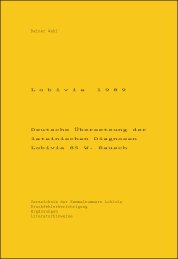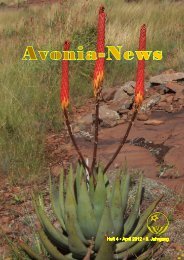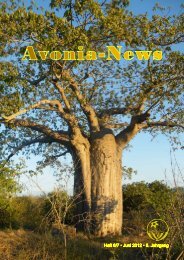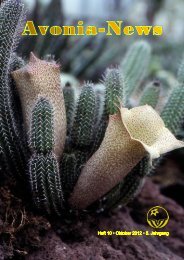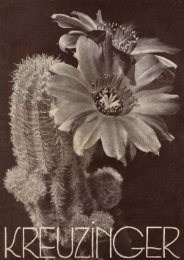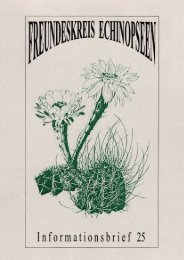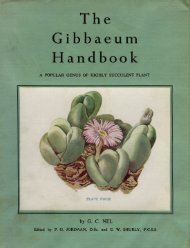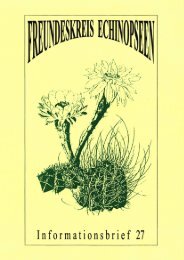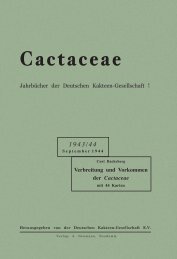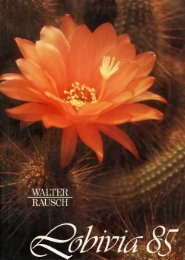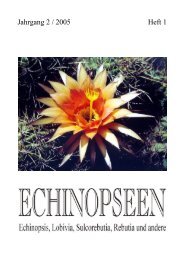- Page 3:
L I T H O P S B Y G . C . N E L
- Page 6 and 7:
Printed by Hortors Limited, 78, Bre
- Page 8 and 9:
page 35. Lithops olivacea 122 36. L
- Page 10 and 11:
figure page 46 . Lithops gracilidel
- Page 13 and 14:
LIST OF COLOURED PLATES Plate 1 . L
- Page 17 and 18:
PREFACE A Monograph on any genus sh
- Page 19 and 20:
INTRODUCTION THE name Lithops is de
- Page 21 and 22:
which enclose between them the new
- Page 23 and 24:
In the ease of Lithops terricolor,
- Page 25 and 26:
L. salicola occurs at two places ap
- Page 27:
fig. 3 . longitudinal section throu
- Page 30 and 31:
It would appear that the top surfac
- Page 32:
colouration: (v) L. Fulleri also ha
- Page 35 and 36:
As will be described later, its mai
- Page 37 and 38:
figure 8 . lithops gracilidelineata
- Page 39 and 40:
to the prevailing winds, and being
- Page 41:
fig. 13 . capsule of lithops optica
- Page 44 and 45:
Pleisopilos > Pleiospilos Lithops >
- Page 46 and 47:
lau”. > blau. He goes on to say t
- Page 48 and 49:
Flower single produced between the
- Page 50 and 51:
soek. Dit is hom geluk om die kleur
- Page 52 and 53:
INLEIDING DIE naam Lithops kom van
- Page 54 and 55:
algemene hou van die plant as gehee
- Page 56 and 57:
in hulle natuurlike woonplek, is pl
- Page 58 and 59:
voor, dat jou moeilikhede begin wan
- Page 60 and 61:
val van ’n plant soos bv. L. pseu
- Page 62 and 63:
westekant van Suid Afrika liet die
- Page 64 and 65:
Luckhoff > Lückhoff 300-350 myl. E
- Page 66 and 67:
In die veld het ek al van tyd tot t
- Page 68 and 69:
Drie plante elkeen waarvan uit twee
- Page 70 and 71:
L. verruculosa, en L. Van‑Zylii,
- Page 72 and 73:
1. LITHOPS AUCAMPIAE * Indicates Or
- Page 75 and 76:
figure 15 . lithops aucampiae l. bo
- Page 77:
plate 2 . lithops aucampiae l. bol.
- Page 81 and 82:
wat heelwat van mekaar in die aard
- Page 84 and 85:
plate 4 . 1 and 2. lithops bella (d
- Page 86 and 87:
verhewe bokant die oppervlakte van
- Page 88 and 89:
figure 19 . lithops bromfieldii l.
- Page 91 and 92:
✱Lithops Brevis. Folia subaequali
- Page 93:
plate 6 . 1. lithops chrysocephala
- Page 97 and 98:
figure 21 . lithops chrysocephala n
- Page 100 and 101:
plate 8 . lithops divergens l. bol.
- Page 102 and 103:
figure 23 . lithops comptonii l. bo
- Page 104 and 105:
figure 25 . lithops comptonii l. bo
- Page 106 and 107:
figure 27 . lithops dendritica nel
- Page 108 and 109:
figure 29 . lithops dinteri schwant
- Page 110 and 111:
figure 31 . lithops divergens l. bo
- Page 112 and 113:
figure 33 . lithops eberlanzii (dtr
- Page 115 and 116:
11. LITHOPS EBERLANZII Lithops Eber
- Page 117 and 118:
✱Lithops Eberlanzii. Corpuscula 2
- Page 119:
plate 10 . lithops erniana loesch e
- Page 122:
figure 38 . lithops fulleri n.e. br
- Page 125 and 126:
lineal lanzettlichen Petalen. Die z
- Page 127:
plate 12 . lithops fulleri n.e. br.
- Page 130 and 131:
the latter is usually very slightly
- Page 134 and 135:
plate 14 . lithops fulviceps n.e. b
- Page 136:
figure 43 . lithops gracilidelineat
- Page 139 and 140:
of numerous ridges and elevations,
- Page 141:
plate 15 . 1. lithops geyeri Nel 2.
- Page 145 and 146:
geisoleer en nie met mekaar verbind
- Page 147:
plate 16 . 1. lithops gulielmi l. b
- Page 150 and 151:
odies. As far as the leaves go, L.
- Page 154 and 155:
plate 17a . lithops herrei l. bol.
- Page 156:
inclusum; receptaculum apicem folio
- Page 159 and 160:
pearing to be solid; outer margin i
- Page 161:
plate 19 . lithops julii (dtr. et s
- Page 164 and 165:
figure 55 . lithops julii (dtr. et
- Page 166 and 167:
figure 57 . lithops julii (dtr. et
- Page 170 and 171:
plate 20a . lithops karasmontana (d
- Page 172 and 173:
Koerpe chens > Koerper chens Kiesel
- Page 174:
figure 60 . lithops kuibisensis dtr
- Page 177 and 178:
Griffel überragen mit ihren zurüc
- Page 179:
plate 21 . lithops kuibisensis dtr.
- Page 182 and 183:
figure 64 . lithops kunjasensis dtr
- Page 186 and 187:
plate 22 . lithops kunjasensis dtr.
- Page 188:
figure 66 . lithops lesliei n.e. br
- Page 191 and 192:
28. LITHOPS LINEATA lineata, > line
- Page 193:
plate 23 . lithops lesliei n.e. br.
- Page 197 and 198:
Lithops marginata. (Plaat 24) Plant
- Page 199:
plate 24 . 1. lithops lineata nel 2
- Page 202 and 203:
figure 72 . lithops marmorata n.e.
- Page 206 and 207:
plate 26 . lithops marthae loesch e
- Page 208:
figure 74 . lithops mennelii l. bol
- Page 211 and 212:
nulla, supra leviter convexum, rose
- Page 213:
plate 28 . lithops meyeri l. bol.
- Page 217 and 218:
figure 77 . lithops meyerii l. bol.
- Page 219:
plate 30 . lithops olivacea l. bol.
- Page 222 and 223:
Fig. 80 is a photo of a group of pl
- Page 226 and 227:
plate 32 . lithops otzeniana nel
- Page 228: South West Africa; growing in sand
- Page 231 and 232: figure 84 . lithops otzeniana nel f
- Page 233: plate 33a . lithops pseudotruncatel
- Page 236 and 237: plözlich > plötzlich übergangsge
- Page 239 and 240: unmittelbaren Nähe des Spaltes bef
- Page 241: plate 33b . lithops pseudotruncatel
- Page 245 and 246: figure 91 . lithops pseudotruncatel
- Page 248 and 249: plate 35 . 1. lithops ruschiorum (d
- Page 250 and 251: Kieselstein oder > Kiesel tein oder
- Page 252 and 253: figure 97 . lithops salicola l. bol
- Page 255 and 256: Plabt > Plate Lithops salicola. (Pl
- Page 257: plate 36 . lithops terricolor n.e.
- Page 261 and 262: windows; numerous minute white dots
- Page 264 and 265: plate 37 . lithops triebneri l. bol
- Page 266 and 267: figure 103 . lithops triebneri l. b
- Page 268 and 269: figure 106 . lithops urikosensis dt
- Page 271 and 272: figure 108 . lithops vallis mariaz
- Page 273: plate 38a . lithops turbiniformis (
- Page 277 and 278: tige tint; buitenste en binneste so
- Page 282 and 283: tirely different to those where the
- Page 284 and 285: ondeursigtig; in die jong stadium i
- Page 287 and 288: South West Africa: Mariental. (Fig.
- Page 289: plate 41a . lithops van zylii l. bo
- Page 293 and 294: deursigtig; boonste vlak wit grys b
- Page 297 and 298: Die planteliggaam is 1.5-2 cm, bree
- Page 299 and 300: deur die geheel ’n gerimpelde voo
- Page 301 and 302: Hierdie twee portrette (Fig. 117-11
- Page 304 and 305: 1. afenestratae KEY TO SPECIES Uppe
- Page 306 and 307: ii. fenestratae Upper surface eithe
- Page 308 and 309: B. aRubRae. Window without red dots
- Page 310 and 311: 172 xx. Window coloured (reddish, m
- Page 312 and 313: ABBREVIATIONS OF LITERATURE ON FOLL
- Page 314 and 315: Lithops Gulielmi L. Bol. in L.B. II
- Page 316: Luckhoff > Lückhoff Lithops salico



